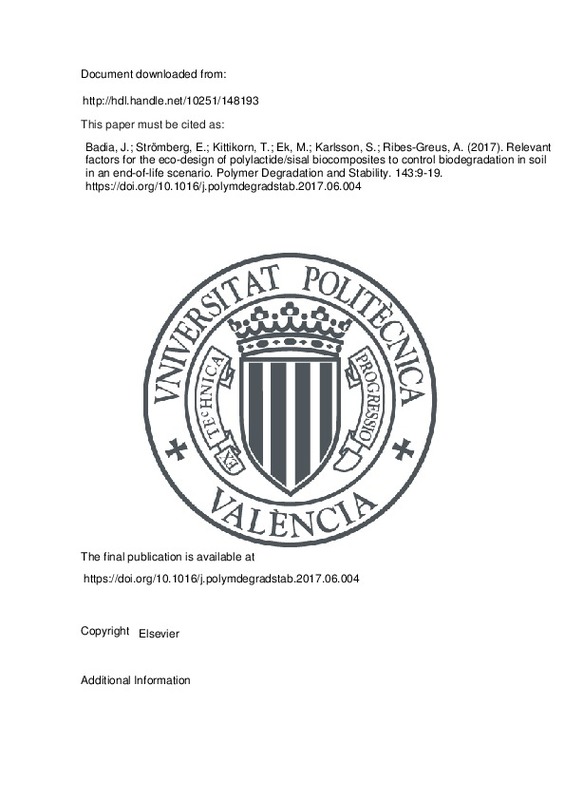Badia, J.; Strömberg, E.; Kittikorn, T.; Ek, M.; Karlsson, S.; Ribes-Greus, A. (2017). Relevant factors for the eco-design of polylactide/sisal biocomposites to control biodegradation in soil in an end-of-life scenario. Polymer Degradation and Stability. 143:9-19. https://doi.org/10.1016/j.polymdegradstab.2017.06.004
Por favor, use este identificador para citar o enlazar este ítem: http://hdl.handle.net/10251/148193
|
Título:
|
Relevant factors for the eco-design of polylactide/sisal biocomposites to control biodegradation in soil in an end-of-life scenario
|
|
Autor:
|
Badia, J.D.
Strömberg, E.
Kittikorn, T.
Ek, M.
Karlsson, S.

 Ribes-Greus, A.
Ribes-Greus, A.
|
|
Entidad UPV:
|
Universitat Politècnica de València. Departamento de Máquinas y Motores Térmicos - Departament de Màquines i Motors Tèrmics
Universitat Politècnica de València. Instituto de Tecnología de Materiales - Institut de Tecnologia de Materials
|
|
Fecha difusión:
|
|
|
Resumen:
|
[EN] The eco-design considers the factors to prepare biocomposites under an end-of-life scenario. PLA/sisal biocomposites were obtained from amorphous polylactide and sisal loadings of 10, 20 and 30 wt% with and without ...[+]
[EN] The eco-design considers the factors to prepare biocomposites under an end-of-life scenario. PLA/sisal biocomposites were obtained from amorphous polylactide and sisal loadings of 10, 20 and 30 wt% with and without coupling agent, and subjected to biodegradation in soil according to standard IS0846. Mass loss, differential scanning calorimetry and size-exclusion chromatography were used for monitoring biodegradation. A statistical factorial analysis based on the molar mass M-n, and crystallinity degree X-c pointed out the relevance and interaction of amount of fibre and use of coupling agent with the time of burial in soil., During the preparation of biocomposites, chain scission provoked a similar reduction of M-n, for coupled and non-coupled biocomposites. The amount of fibre was relevant for the increase of Xc due to the increase of nucleation sites. The coupling agent accelerated the evolution of both factors: reduction of M-n, and the consequent increase of Xc, mainly during biodegradation in soil. Both factors should be balanced to facilitate microbial assimilation of polymer segments, since bacterial digestion is enhanced by chain scission but blocked by the promotion of crystalline fractions. (C) 2017 Elsevier Ltd. All rights reserved.
[-]
|
|
Palabras clave:
|
Polylactide (PLA)
,
Natural fibre
,
Sisal
,
Biocomposite
,
Degradation
,
Biodegradation in soil
,
Design of experiments
,
Statistical factorial analysis
,
Size exclusion chromatography
,
Differential scanning calorimetry
|
|
Derechos de uso:
|
Reserva de todos los derechos
|
|
Fuente:
|
Polymer Degradation and Stability. (issn:
0141-3910
)
|
|
DOI:
|
10.1016/j.polymdegradstab.2017.06.004
|
|
Editorial:
|
Elsevier
|
|
Versión del editor:
|
https://doi.org/10.1016/j.polymdegradstab.2017.06.004
|
|
Código del Proyecto:
|
info:eu-repo/grantAgreement/MINECO//UPOV13-3E-1947/ES/Cromatrografía por Exclusión de Tamaños/
info:eu-repo/grantAgreement/MINECO//ENE2014-53734-C2-1-R/ES/DISEÑO Y VALIDACION DE MEMBRANAS CON CONTROL MORFOLOGICO PARA SU USO EN PILAS DE COMBUSTIBLE DE BAJA TEMPERATURA SOSTENIBLES EN VEHICULOS EFICIENTES NO TRIPULADOS/
info:eu-repo/grantAgreement/GVA//APOSTD%2F2014%2F041/
|
|
Agradecimientos:
|
The authors would like to acknowledge the European Regional Development Funds and the Spanish Ministry of Economy and Competitiveness, through the Research Projects ENE2014-53734-C2-1-R and UPOV13-3E-1947. Generalitat ...[+]
The authors would like to acknowledge the European Regional Development Funds and the Spanish Ministry of Economy and Competitiveness, through the Research Projects ENE2014-53734-C2-1-R and UPOV13-3E-1947. Generalitat Valenciana is thanked for the APOSTDI4/041 program for J.D. Badia. The financial support given by the Prince of Songkla University and KTH Royal Institute of Technology is gratefully acknowledged.
[-]
|
|
Tipo:
|
Artículo
|







![[Cerrado]](/themes/UPV/images/candado.png)


